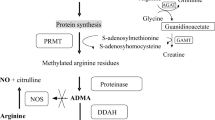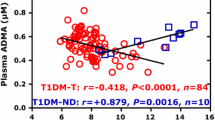Abstract
Introduction
Free asymmetric dimethylarginine (ADMA) is a competitive inhibitor of the nitric oxide synthases (NOS). Suppression of nitric oxide (NO) synthesis increases the risk of atherosclerosis. Nevertheless, in the condition of oxidative stress, NOS blockade by ADMA may exert protective effects. Protein metabolism is altered in patients with phenylketonuria (PKU) on dietary treatment and as shown recently, oxidative stress is high in PKU. Since free ADMA concentrations are determined by both protein metabolism and oxidative stress we hypothesized, that free ADMA levels may be elevated in PKU patients.
Design
Sixteen patients with PKU on dietary treatment (mean age 10.1 ± 5.2 yrs), and 91 healthy children (mean age 11.6 ± 3.7 yrs) participated in a cross sectional study.
Results
ADMA, total homocysteine (tHcy) and blood glucose were lower and the L-arginine/ADMA ratio was higher in PKU patients compared to controls. No significant correlation was present between phenylalanine (Phe) concentrations, protein intake, and lipid profile, history of cardiovascular disease or ADMA.
Discussion
In contrast to our hypothesis, ADMA was lower and the L-arginine/ADMA ratio was higher in PKU patients. Therefore, in PKU patients, the regulating function of ADMA on NO synthesis is altered and may thus contribute to oxidative stress.
Similar content being viewed by others

Abbreviations
- ADMA:
-
asymmetric dimethylarginine
- CVD:
-
cardiovascular disease
- DDAH:
-
dimethylarginine dimethylaminohydrolase
- HDL:
-
high density lipoprotein
- NOS:
-
nitric oxide synthase(s)
- NO:
-
nitric oxide
- Phe:
-
phenylalanine
- PKU:
-
phenylketonuria
- tHcy:
-
total homocysteine
References
Anderssohn M, Schwedhelm E, Lüneburg N, Vasan RS, Böger RH (2010) Asymmetric dimethylarginine as a mediator of vascular dysfunction and a marker of cardiovascular disease and mortality: an intriguing interaction with diabetes mellitus. Diab Vasc Dis Res 7:105–118
Beltowski J, Kedra A (2006) Asymmetric dimethylarginine (ADMA) as a target for pharmacotherapy. Pharmacological Reports 58:159–178
Böger RH, Maas R, Schulze F, Schwedhelm E (2005) Elevated levels of asymmetric dimethylarginine (ADMA) as a marker of cardiovascular disease and mortality. Clin Chem Lab Med 43:1124–1129
Burgard P, Bremer HJ, Bührdel P, Clemens PC, Mönch E, Przyrembel H, Trefz FK, Ullrich K (1999) Rationale for the German recommendations for phenylalanine level control in phenylketonuria. Eur J Pediatr 158:46–54
Channon S, Goodman G, Zlotowitz S, Mockler C, Lee PJ (2007) Effects of dietary management of phenylketonuria on long-term cognitive outcome. Arch Dis Child 92:213–218
Daenzer M, Petzke KJ, Bequette BJ, Metges CC (2001) Whole body nitrogen and splanchnic amino acid metabolism differ in rats fed mixed diets containing casein or its corresponding amino acid mixture. J Nutr 131:1965–1972
Ellger B, Richir MC, van Leeuwen PA, Debaveye Y, Langouche L, Vanhorebeek I, Teerlink T, Van den Berghe G (2008) Glycemic control modulates arginine and asymmetrical-dimethylarginine levels during critical illness by preserving dimethylarginine-dimethylaminohydrolase activity. Endocrinology 149:3148–3157
Engler MM, Engler MB, Malloy M, Chiu E, Besio D, Paul S, Stuehlinger M, Morrow J, Ridker P, Rifai N, Mietus-Snyder M (2004) Docosahexaenoic acid restores endothelial function in children with hyperlipidemia: results from the EARLY study. Int J Clin Pharmacol Ther 42:672–679
Goonasekera CD, Shah V, Rees DD, Dillon MJ (2000) Vascular endothelial cell activation associated with increased plasma asymmetric dimethyl arginine in children and young adults with hypertension: a basis for atheroma? Blood Press 9:16–21
Gorenflo M, Zheng C, Werle E, Fiehn W, Ulmer HE (2001) Plasma levels of asymmetrical dimethyl-L-arginine in patients with congenital heart disease and pulmonary hypertension. J Cardiovasc Pharmacol 37:489–492
Kanzelmeyer N, Tsikas D, Chobanyan-Jürgens K, Beckmann B, Vaske B, Illsinger S, Das AM, Lücke T (2011) Asymmetric dimethylarginine in children with homocystinuria or phenylketonuria. Amino Acids doi:10.1007/s00726-011-0892-4 [Epub ahead of print]
Kari JA, Donald AE, Vallance DT, Bruckdorfer KR, Leone A, Mullen MJ, Bunce T, Dorado B, Deanfield JE, Rees L (1997) Physiology and biochemistry of endothelial function in children with chronic renal failure. Kidney Int 52:468–472
Lin KY, Ito A, Asagami T, Tsao PS, Adimoolam S, Kimoto M, Tsuji H, Reaven GM, Cooke JP (2002) Impaired nitric oxide synthase pathway in diabetes mellitus: role of asymmetric dimethylarginine and dimethylarginine dimethylaminohydrolase. Circulation 106:987–992
Lücke T, Kanzelmeyer N, Kemper MJ, Tsikas D, Das A (2007) Developmental changes in the L-arginine / nitric oxide pathway from infancy to adulthood: plasma asymmetric dimethylarginine levels decrease with age. Clin Chem Lab Med 45:1525–1530
Marcovecchio ML, Widmer B, Dunger DB, Dalton RN (2008) Effect of acute variations of insulin and glucose on plasma concentrations of asymmetric dimethylarginine in young people with type 1 diabetes. Clin Sci 115:361–369
Mönch E, Herrmann ME, Brösicke H, Schöffer A, Keller M (1996) Utilisation of amino acid mixtures in adolescents with phenylketonuria. Eur J Pediatr 155:S115–S120
Pitocco D, Zaccardi F, DI Stasio E, Romitelli F, Martini F, Scaglione GL, Speranza D, Santini S, Zuppi C, Ghirlanda G (2009) Role of asymmetric-dimethyl-L-arginine (ADMA) and nitrite/nitrate (NOx) in the pathogenesis of oxidative stress in female subjects with uncomplicated type 1 diabetes mellitus. Diab Res Clin Practice 86:173–176
Sanayama Y, Nagasaka H, Takayanagi M, Ohura T, Sakamoto O, Ito T, Ishige-Wada M, Usui H, Yoshino M, Ohtake A, Yorifuji T, Tsukahara H, Hirayama S, Miida T, Fukui M, Okano Y (2011) Experimental evidence that phenylalanine is strongly associated to oxidative stress in adolescents and adults with phenylketonuria. Mol Genet Metab 103:220–225
Schulze F, Maas R, Freese R, Schwedhelm E, Silberhorn E, Böger RH (2005) Determination of a reference value for N(G), N(G)-dimethyl-L-arginine in 500 subjects. Eur J Clin Invest 35:622–626
Schulze F, Lenzen H, Hanefeld C, Bartling A, Osterziel KJ, Goudeva L, Schmidt-Lucke C, Kusus M, Maas R, Schwedhelm E, Strödter D, Simon BC, Mügge A, Daniel WG, Tillmanns H, Maisch B, Streichert T, Böger RH (2006) Asymmetric dimethylarginine is an independent risk factor for coronary heart disease: results from the multicenter Coronary Artery Risk Determination investigating the Influence of ADMA Concentration (CARDIAC) study. Am Heart J 152(493):e1–e8
Sydow K, Münzel T (2003) ADMA and oxidative stress. Atheroscler Suppl 4:41–51
Acknowledgements
We are indebted to all study participants and their families, to the Dept. of Anesthesia and ENT at the Landeskrankenhaus Feldkirch, to the participating Pediatricians and Mrs. Helbok-Blum for their support. We gratefully acknowledge the Federal Government of Vorarlberg for financial support of our work.
Details of funding
The work has been funded by the Federal Government of Vorarlberg, Austria. The authors confirm independence from the sponsors; the content of the article has not been influenced by the sponsors.
Author information
Authors and Affiliations
Corresponding author
Additional information
Communicated by: K. Michael Gibson
Rights and permissions
About this article
Cite this article
Huemer, M., Simma, B., Mayr, D. et al. Free asymmetric dimethylarginine (ADMA) is low in children and adolescents with classical phenylketonuria (PKU). J Inherit Metab Dis 35, 817–821 (2012). https://doi.org/10.1007/s10545-011-9448-8
Received:
Revised:
Accepted:
Published:
Issue Date:
DOI: https://doi.org/10.1007/s10545-011-9448-8



